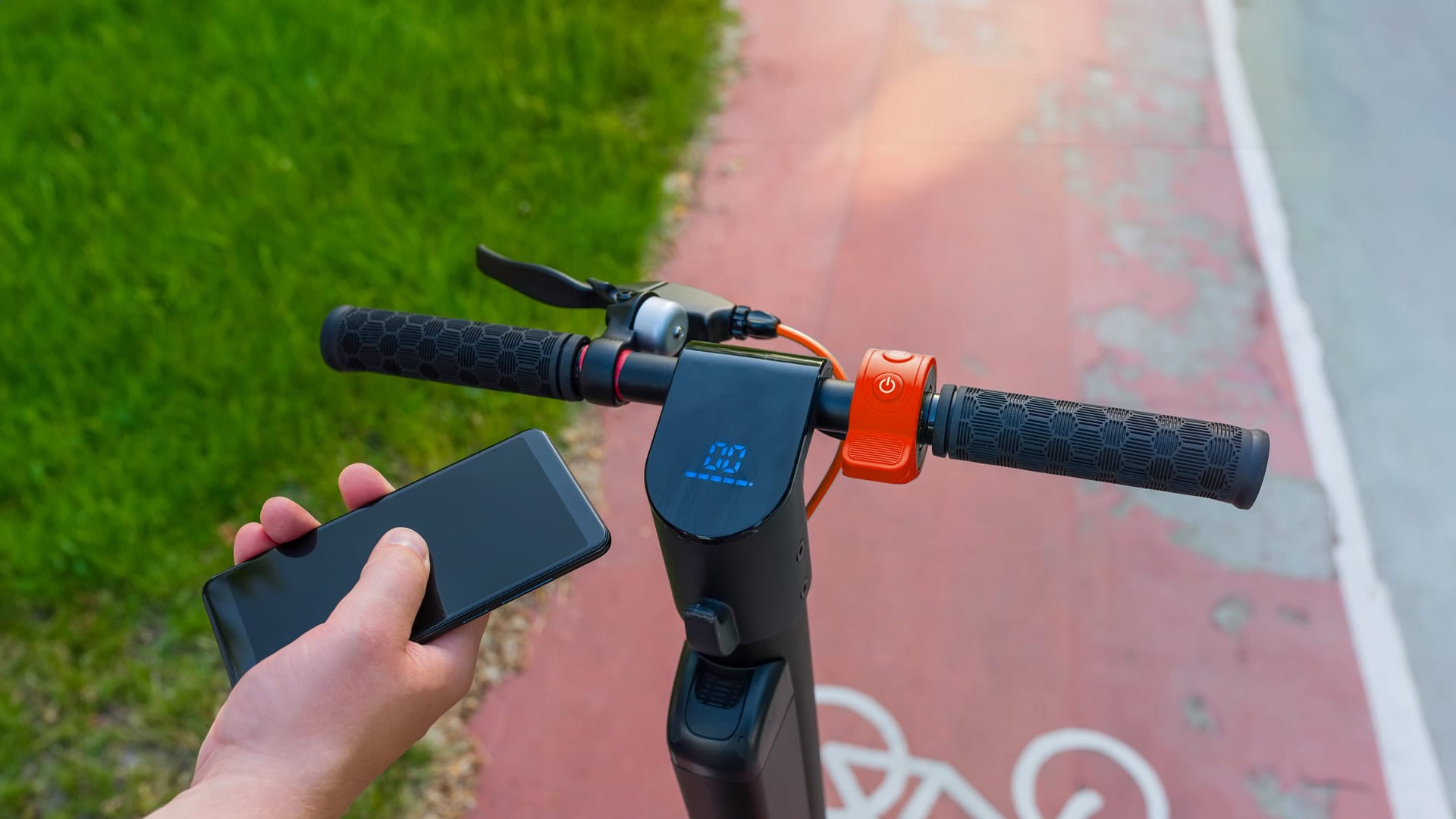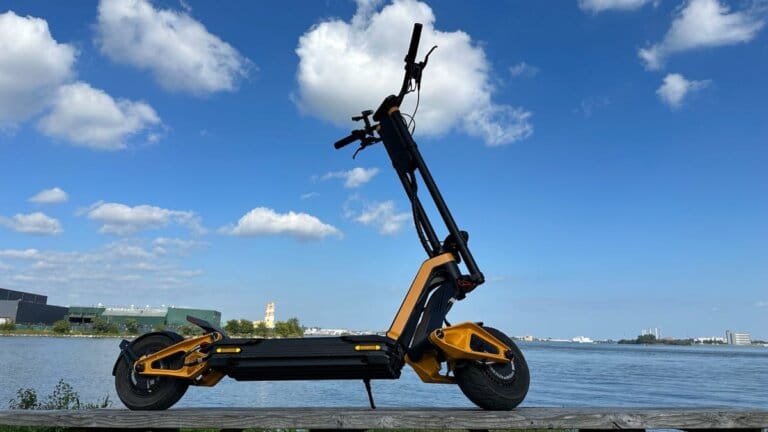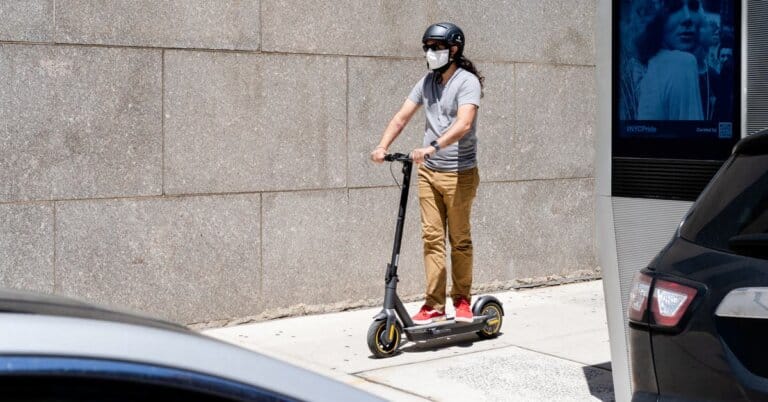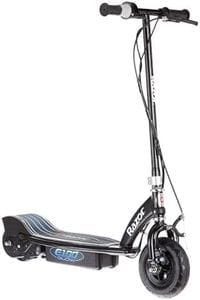The 6 Best Electric Scooters for Kids in 2025
Electric scooters for kids can be fun, but safety comes first. In this guide, I cut through the hype and help you pick a scooter that’s safe, reliable, and right for your kid’s age and size.
When I recommend scooters for adults, it’s typically about performance value, speed, and range, but for kids, things are different. To select the best e-scooters for kids (ages 6 through teens), I’ve focused on the following:
- Safety features (good brakes, speed limiters)
- Manageable speed (no overpowered motors, preferably with adjustability)
- Reliability (sturdy builds, good after-sales support)
- Low maintenance (no fixer-uppers that break when you blink)
Although less common, I’ve also included several models with adjustable handlebar heights so the kids can grow with their scooters.
Quick Overview
I’ve kept things simple with six reliable models from three popular brands.
Top 6 Electric Scooters for Kids
Max Speed
10 MPH
Battery Range
40-60 min
Weight Limit
143 lbs
What I like
- Reputable brand with good support
- Adjustable height for growing kids
- Excellent visibility with multiple lights
- Lightweight and low maintenance
- Kid-friendly speed and controls
What I don’t like
- Limited battery runtime
- Lacks a mechanical hand brake
- Not geared for rough terrain
The Gyroor H40 makes the list for several reasons. Gyroor’s one of the most popular brands in the industry, with a good after-sales reputation. The scooter itself is solid, fitting kids 8-14 years old with an adjustable handlebar height. Visibility’s a strong point here, with a full setup of deck lights, headlight, and taillight – great for safety.
It’s lightweight at just 9.3 lbs, which makes it easy for kids to handle. The low maintenance design is a big plus, featuring an electronic regen brake and footbrake. No fussy cables or adjustments needed. Power-wise, we’re looking at a manageable 180W motor that tops out at 10 mph – fast enough to be fun, slow enough to keep parents from excessive worry (or freaking out!)
The battery capacity is on the small side, so you’re likely to get 40-60 minutes of runtime per charge. That’s enough for neighborhood cruising, but don’t expect all-day adventures. I’d have liked to see a mechanical hand brake in addition to the electronic and footbrake systems, but the setup is safe enough for the modest speed.
Control-wise, it’s got an intuitive thumb throttle which is easy for kids to learn and manage. The 7″ wheels should handle typical sidewalks and paths without issue.
Max Speed
10 MPH
Battery Range
40-60 min
Weight Limit
132 lbs
What I like
- 3-speed modes great for learning
- Built-in Bluetooth speaker
- Adjustable height for growing kids
- Very affordable price point
What I don’t like
- Limited visibility (only deck lights)
- Heavier than the H40
The Gyroor H30 Max is another solid scooter for a slightly younger crowd of 6-12 years. It’s got a lot of similarities to the H40, but with some key differences that make it more suitable for younger riders.
We’re looking at a 150W rear motor, which is slightly less powerful than the H40 (180W), but that’s perfect given that this is for kids aged 6 and up. It still manages to hit the same 10 MPH top speed.
One of the best features of the H30 Max is the 3-speed mode setup – 6, 8 and 10 MPH. This is great for letting your kid gradually work up to higher speeds as they get comfortable, and helps keep things safe and manageable from a parent’s perspective.
Battery-wise, it’s the same deal as the H40 – expect about 40-60 minutes of ride time. The weight capacity is a bit lower at 132 lbs, but that makes sense for the younger age range.
Visibility isn’t as decked out as the H40 – you’re only getting deck lights here. But Gyroor’s thrown in a Bluetooth speaker, which is a fun touch that your kid might appreciate.
The adjustable handlebar is still here, ranging from 34″ to 38″. It’s a bit heavier than the H40 at 13.2 lbs, but still manageable for most kids in the 3’6″ to 5’3″ range.
Like its bigger sibling, it’s using a combo of rear fender footbrake and electronic brake. Again, I’d prefer a mechanical hand brake, but it should be plenty safe at these speeds.
Max Speed
12.4 MPH
Battery Range
60-120 min
Weight Limit
132 lbs
What I like
- One of the fastest in the lineup
- Very good range
- Solid braking system
- Top-tier brand reliability
What I don’t like
- Heavy for younger kids
- Limited visibility
- No true slow mode for beginners
If you’re looking for something a bit more capable, the Segway Ninebot C2 Pro has a zippy but manageable top speed of 12.4 MPH. It’s got three speed modes – 9.3 mph and two modes capped at 12.4 mph (I would’ve preferred a lower starting mode instead of two top speed modes).
Braking performance is top-notch with both an electronic regen brake and a rear drum brake operated by a hand lever. It packs a 108 Wh battery, which is significantly larger than the Gyroor models offer, so the C2 Pro will give you the best range per charge in this kids’ category, hands down. More range, more fun.
Visibility could’ve been better. It’s missing a headlight and taillight. The ambient deck-light is great, though. It’s notably heavier than some competitors at 23.6 lbs, so younger kids won’t be lugging this around easily. However, that’s often a sign of its build quality. It feels grounded and like it’s gonna last.
The handlebar height is adjustable and will theoretically fit kids within the 3’8″-5’6″ height range (roughly 6-14 years), but I recommend it for kids aged 9 and up. The weight and speed make it more suitable for older or more experienced kids.
Brand-wise, you can’t beat Segway for reliability. They’re arguably the biggest name in the game. The Bluetooth speaker’s a nice touch too, something to keep the fun going.
Max Speed
9.9 MPH
Battery Range
40-60 min
Weight Limit
110 lbs
What I like
- Reliable Segway build quality
- Appropriate speed for younger kids
- Solid braking system
- More affordable than C2 Pro
What I don’t like
- Heavy for its target age group
- No adjustable handlebar
- No Bluetooth speaker
The Segway Ninebot C2 is like a toned-down version of the C2 Pro, aimed squarely at the 6-12 age bracket. It’s got a more modest 54Wh battery, putting its range in line with the Gyroor models – expect about 40-60 minutes of ride time (up to approx. 6.8 miles).
Power-wise, we’re looking at a 130W nominal motor. It’s one of the least powerful in our lineup, but still manages a respectable 9.9 MPH top speed. You’ve got three speed modes here – one capped at 7.5 MPH and two capped at 9.9 MPH. I’d have preferred a slower starting mode instead of two top speed modes, but the 7.5 MPH option is a good starting point for beginners.
At 22.9 lbs, it’s a tad lighter than the C2 Pro, but still noticeably heavier than some lighter competitors like the Gyroor models. The 110 lbs weight limit is on the lower side, but should cover most kids in the target age range. One drawback is the lack of adjustable handlebars, but it should comfortably fit kids from 3’9″ to 5’2″.
Unlike its Pro sibling, there’s no Bluetooth speaker here. But let’s be real – you’re buying this for the ride, not the music.
What you do get is Segway’s top-notch reliability and build quality. It’s a solid, dependable option for younger riders, even if it’s not perfect. If you’re after something well-built that’ll last, this is worth a look.
Max Speed
10 MPH
Battery Range
50-70 min
Weight Limit
132 lbs
What I like
- Two good speed modes
- Half-twist throttle, easier on kids’ hands
- Comfortable ride with larger wheels
- Typically the warranty in the lineup
- Solid braking system (Mechanical + Regen)
- Swappable grip tape
What I don’t like
- Non-adjustable handlebar height
- Heavier than the Gyroor models
- Limited lighting (no front/rear lights)
The NIU KQi Youth+ is another strong contender, offering some unique features. It’s got two speed modes that make sense – a safe 6.2 MPH and a sportier 10 MPH. That’s a good spread for kids to grow into.
One thing that stands out is the half-twist throttle. Some find it easier on the hands than a thumb throttle, which can be great for younger riders who may not have built up as much finger dexterity or strength yet. I also like the swappable grip tape on the deck. When it wears down, you’re not stuck with a slippery ride. There are some fun design options, too.
Comfort-wise, this could be the winner for some. The 7.5″ front and 7″ rear wheels are among the largest in our kids’ group, which should translate to a smoother ride on typical surfaces.
The ambient deck light adds some style, but it’s still missing front and rear lights for better visibility. It’s a common theme in this lineup, and I wish more manufacturers would prioritize lighting.
Weight-wise, it sits between the Gyroors and the Ninebots at 18.3 lbs. It’s not super light, but it feels solid and grounded. The non-adjustable handlebar is a bit of a letdown, but NIU says it’ll fit kids in the height range of 4’4″-5’3″ (roughly 8-14 years).
Range is decent at 50-70 minutes (approx. 7.5 miles), beating out the Gyroors and the C2, but still behind the C2 Pro. The braking system is solid, combining electronic regen and a mechanical rear brake (likely drum, operated by hand lever).
Lastly, the Niu KQi Youth+ typically comes with a 2-year warranty, which is often the best coverage in our lineup. If you’re worried about longevity, that’s a big plus.
Max Speed
17.4 MPH
Battery Range
60-120 min
Weight Limit
265 lbs
What I like
- Excellent performance (speed, range, 10% hill climb) for teens
- Superior ride comfort
- Dual brakes and strong lights
- Robust build quality, high weight limit
- Smart app features
What I don’t like
- Much heavier than alternatives
- Higher top speed requires rider maturity
- More expensive
For responsible teens or older kids (manufacturer recommends 14+, but potentially suitable for mature 12/13 year olds under supervision where legally allowed), the NIU KQi 100P represents a significant step up in capability. Always check and adhere to local laws regarding e-scooter age and speed limits.
This scooter delivers much greater performance, hitting a 17.4 mph top speed with a range of up to 18 miles (expect 60-120 minutes of real-world runtime). Its 300W rated (600W peak) motor tackles hills up to 15% grade effectively.
Comfort is exceptional thanks to front dual-spring suspension and large 9.5″ pneumatic tires that soak up bumps well. Safety is also well-addressed with a front drum brake paired with rear regenerative braking, plus a high-powered headlight, brake lights, and side reflectors.
Smart connectivity via the NIU App is a major plus, offering cruise control, remote locking, custom start speeds, charging limits (for battery health), and ride stats. It also features 5 distinct riding modes.
The trade-off for this performance is weight (38.1 lbs) and the need for greater rider responsibility due to the higher speed. While its 265 lbs weight limit accommodates larger riders, its primary appeal here is as a feature-rich, comfortable, and capable scooter for teens ready for more performance.
How to Keep Your Kids Safe on an Electric Scooter
Here are six simple steps you can take as a parent to ensure safe riding.
- Always supervise your kids when they ride: This doesn’t mean hovering, but being present and aware of their location and riding behavior.
- Choose low-traffic areas with smooth roads or paths: Quiet neighborhoods, parks, or dedicated bike paths are ideal. Avoid busy streets or areas with lots of obstacles.
- Teach them how to use the scooter properly: Before their first ride, show them how to start, stop, turn, and use the throttle and brakes safely. Practice together in a safe area until you’re confident in their skills.
- Consider starting with a regular kick scooter: This will help them develop balance and coordination skills before going electric.
- Make wearing safety gear a non-negotiable habit: This includes a properly fitting helmet, knee pads, and elbow pads at minimum. Explain why each piece is important and lead by example if you ride with them.
- Set clear rules and enforce them consistently: This might include restrictions on riding at night, in certain areas, or regarding speed limits.
Essential Safety Gear for Young E-Scooter Riders
- Helmet: This is the most essential piece of safety equipment. Choose a well-fitting bicycle or skateboard helmet that meets safety standards (e.g., CPSC in the US, EN 1078 in Europe). Always replace a helmet if it’s been in a crash.
- Knee and Elbow Pads: These protect against scrapes and bruises in case of falls. Look for pads with hard shells and soft interiors for comfort.
- Wrist Guards: These can prevent wrist injuries during falls, which are common when kids instinctively try to catch themselves.
- Closed-toe Shoes: Avoid sandals or flip-flops. Sturdy, closed-toe shoes provide better grip and protect feet.
- Visibility Aids: If your child rides in low-light settings, consider bright or reflective clothing. This helps a lot with visibility. Many of these children’s scooters have poor built-in lighting, so it may be worth adding extra bike lights as well (front white, rear red).
At the end of the day, the best safety gear is the gear that’s actually worn. Make it a habit from day one, and your kid will be much safer on their scooter.
Parents Questions Answered
There isn’t a one-size-fits-all answer here. It depends on your kid’s development, coordination level, and maturity. Some kids are ready earlier than others. That said, most reputable brands design their kids’ scooters for ages 6 and up, which is generally a good starting point.
The key is to choose a scooter that’s appropriate for your child’s age, size, and skill level. This means considering factors like speed limits and ride height to ensure they have a stable, safe ride. Definitely don’t get an adult-sized scooter for a kid—they’re simply not tall enough or often skilled enough to handle those dimensions or power levels yet. Always check local laws for minimum age requirements.
Kids aged around 6-8 are best off on scooters topping out around 6-8 MPH, while they can gradually ease towards 10-12 MPH as they approach their tweens (9-12). Older teens (12/14+) might handle speeds up to 17 MPH or slightly more, depending on the model, maturity, and local laws. This is generally aligned with how manufacturers design their kids’ and youth scooters.
The ideal top speed depends on your kid’s ability and coordination level. Here’s a rough guide to help you match age with appropriate scooter specs:
| Age | Max Speed |
|---|---|
| 6-8 | 6-8 MPH |
| 9-11 | 8-10 MPH |
| 12-14 | 10-12 MPH |
| 14+ (Teens) | 12-17+ MPH |
Adjustable handlebars aren’t strictly necessary, but they’re a big plus. They allow the scooter to grow with your kid, potentially lasting several years instead of just one summer.
This can save you money in the long run and ensures a comfortable, safe riding position as your child grows. However, if you find a scooter that fits your kid perfectly now and has all the other features you want, don’t rule it out just because the handlebars aren’t adjustable.
For kids, thumb throttles are generally considered slightly better by some. They’re often easier to control precisely and less likely to cause accidental acceleration when gripping tightly.
However, the NIU KQi Youth+ in our lineup uses a half-twist throttle, which can be easier on the hands for some kids, especially if they haven’t developed much finger dexterity or strength yet.
Ultimately, either type can work well if the child is properly trained on how to use it safely. The most important factor is that the throttle is responsive and easy for your kid to manage.
Electric scooter laws vary significantly by location, so you must check the specific rules for your area before your child rides. Regulations differ widely on minimum age, speed limits, helmet requirements, and where riding is permitted (like sidewalks, bike paths, or roads) – be aware that sidewalk use is often restricted.
Don’t assume rules are the same everywhere; look up your local city or government website, or contact them directly, to confirm the details and ensure your child rides legally and safely. Regardless of local laws, always make sure your child wears a helmet for safety.
Proper battery care is crucial for safety and the scooter’s lifespan. Always use the original manufacturer’s charger and avoid leaving it plugged in excessively long after it’s full; unplug it unless it has charge-limiting features. Charge in a dry, open space away from flammable items, avoid leaving it charging completely unattended (especially overnight), and let the scooter cool briefly before and after charging.
For long-term storage, like over winter, keep the battery partially charged (around 40-70%) in a cool, dry place. Always check the manufacturer’s manual for their specific charging and storage guidance.










One Comment
Comments are closed.